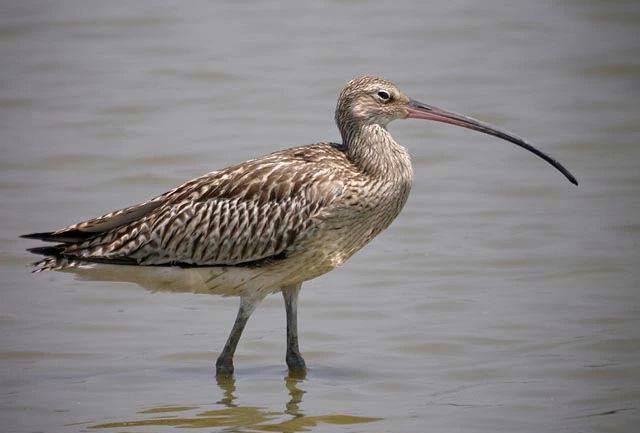Numenius arquata
IUCN
LCBasic Information
Scientific classification
- name:Numenius arquata
- Scientific Name:Numenius arquata,Eurasian Curlew,Curlew
- Outline:Wading birds
- Family:Charadriformes S.family C.genus
Vital signs
- length:57.5-62.5cm
- Weight:659-1000g
- lifetime:10-20 years or so
Feature
White pinnacles serrated
Distribution and Habitat
It is found in Afghanistan, Albania, Algeria, Angola, Armenia, Austria, Azerbaijan, Bahrain, Bangladesh, Belarus, Belgium, Benin, Bhutan, Bosnia and Herzegovina, Botswana, the British Indian Ocean Territory of Brunei, Bulgaria, Burkina Faso, Burundi, Cambodia, Cameroon, Chad, China, Comoros, and Congo Democratic Republic of Congo, Cote d 'Ivoire, Croatia, Cyprus, Czech Republic, Denmark, Djibouti, Egypt, Equatorial Guinea, Eritrea, Estonia, Ethiopia, Faroe Islands, Finland, France, Gabon, Gambia, Georgia, Germany, Ghana, Gibraltar, Greece, Guam, Guinea, Guinea-Bissau, Hungary, Iceland, India , Indonesia, Iran (Islamic Republic of), Iraq, Ireland, Israel, Italy, Japan, Jordan, Kazakhstan, Kenya, Democratic People's Republic of Korea, Republic of Korea, Kuwait, Kyrgyzstan, Lao People's Democratic Republic, Latvia, Lebanon, Liberia, Libya, Liechtenstein, Lithuania, Luxembourg, Malta Tun, Madagascar, Malawi, Malaysia, Maldives, Mali, Malta, Mauritania, Mauritius, Mayotte, Mo
Appearance
The head and upper body of curlews are light brown, densely covered with dark brown plumage. The plumage widens from the top of the hindneck to the top of the dorsal plumage. Upper wing cover with serrated black brown pinnacles. The tertiary flight feathers have dark brown long shaped spots, the primary and secondary flight feathers have dark brown light transverse spots, the outer 5 primary flight feathers inside the web, the rest of the flight feathers inside and outside the web have serrated white feathers. The first primary feathers are white, covered with white feathers on the lower back, waist and tail, and have fine grayish-brown feathers on the lower back. The overlying feathers on the tail become thicker, black-brown, and the tail feathers are also white with narrow black-brown stripes. Face light brown with brown fine lines. Chin and throat grayish white, front neck, neck side, chest and abdomen brown-white or light brown, with grayish brown longitudinal lines; Abdomen and fl
Details
There are two subspecies, Eurasian Curlew.

It is a summer migratory bird in northeastern Inner Mongolia, Heilongjiang and Jilin, and specimens were collected in eastern Liaoning in April and May, and may also breed. Wintering in the middle and lower reaches of Yangtze River and southeast coastal provinces of China. The time to move to the northeast breeding ground in spring is from early April to mid-April, and the time to leave the breeding ground in autumn is from early October to late October, and a few are seen in the northeast breeding ground as late as early November.
Curlews often move in small groups. Sexual alertness, slow and steady activity, from time to time to look around, find danger, fly away immediately, and accompanied by a 'go-ee' call. Powerful flight, slow flapping of the wings. It feeds mainly on crustaceans, mollusks, worms, insects and insect larvae, but also pecks at small fish and frogs. They often dig their long, downward curved mouths into the mud as they walk.
The breeding period is from May to July. By the end of April, couples will be seen and courtship flights will take place. Nest building begins in early May. They usually nest in forests near open swampy wetlands, lakes and streams, sometimes 2-3 km away from the water. The nest is mostly located on dry ground or in a dry place on a mound in a swamp. The nest is very simple, mainly using natural pits on the ground or making a pit on the ground with dead grass inside. There are usually 4 eggs per clutch, but occasionally as few as 3 eggs and as many as 5 or even 6 eggs. The eggs are green or olive yellow in color with brown spots. The size of the eggs is 66.5-71 x 46-50 mm. Male and female birds incubate eggs in turn, if there is disturbance when incubating eggs, birds often bend their backs and lower their bodies to secretly leave the nest, generally do not take off. Incubation period is 28-30 days.
The number of white curlew is rare and not widespread, and several key communities and the whole are in moderate and rapid decline globally, which should be protected.
Listed on the International Union for Conservation of Nature Red List of Threatened Species (IUCN) ver 3.1:2008-2017 - Threatened (NT).
It was included in the List of Land Wild Animals under State Protection that are beneficial or have important economic and scientific research value (Item 132) issued by the State Forestry Administration of China on August 1, 2000.
Listed in China's "National Key Protected Wildlife List" (February 5, 2021) Level 2.
Protect wild animals and eliminate wild meat.
Maintaining ecological balance is everyone's responsibility!








